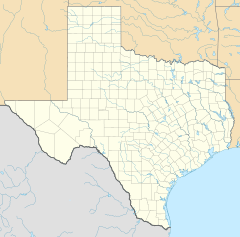Garden City, Texas facts for kids
Quick facts for kids
Garden City, Texas
|
|
|---|---|
| Country | United States |
| State | Texas |
| County | Glasscock |
| Area | |
| • Total | 1.8 sq mi (4.6 km2) |
| • Land | 1.8 sq mi (4.6 km2) |
| • Water | 0 sq mi (0.0 km2) |
| Population
(2020)
|
|
| • Total | 334 |
| • Density | 189/sq mi (72.9/km2) |
| Time zone | UTC-6 (Central (CST)) |
| • Summer (DST) | UTC-5 (CDT) |
| ZIP codes |
79739
|
| FIPS code | 48-28176 |
| GNIS feature ID | 1336388 |
Garden City is a small community in Texas, United States. It is a census-designated place (CDP), which means it's a special area defined by the government for counting people. Garden City is also the county seat of Glasscock County. This means it's where the main government offices for the county are located.
In 2020, about 334 people lived in Garden City. It's located near the middle of Glasscock County, about 27 miles south of a bigger town called Big Spring. The ZIP code for Garden City is 79739.
Contents
History of Garden City
How Garden City Got Its Name
The story of Garden City began in 1886. That year, a post office was set up inside a general store. A small community started to grow around this store. The post office was supposed to be named after the store owner, a man named Gardner. But, because of a mistake by officials in Washington, the name "Garden" City was used instead. And that's how the town got its unique name!
Early Development and Moving Day
Garden City was the first community in Texas to be planned out by a famous surveyor named W. D. Twichell. A surveyor is someone who measures and maps out land.
In 1893, Glasscock County was officially formed. Several communities wanted to be the county seat, including Garden City, New California, and Dixie. New California was chosen at first because it had a better water supply and was less likely to flood. However, New California was very small, with only two houses. Garden City, on the other hand, already had a school, the general store with the post office, and several homes.
So, in a very unusual agreement, most of Garden City's buildings were put on wheels! They were then moved to the New California site. On April 5, 1893, the combined settlement was officially renamed Garden City. Later that year, a two-story stone courthouse was built. A newer, bigger courthouse was built in 1910, but the old one was still used as the county jail.
Growth and Oil Discovery
Between 1927 and 1943, Garden City's population changed a lot, usually staying between 100 and 250 people. Over time, different businesses opened and closed, and the town even had its own newspaper, the Garden City Gazette. By 1945, there were eight businesses and about 200 people living there.
In the 1950s, oil was found nearby. This discovery brought a lot of new activity to the area. While Garden City's population didn't grow as much as some other "oil boom" towns in West Texas, the number of businesses almost doubled between 1947 and 1968. The population reached its highest point of 300 people in 1968. By 1980, the population had gone down to 293, and it stayed around that number until 2010, when the census counted 334 residents.
Modern Times
The area around Garden City is good for making wind power. This is true for much of West Texas. Because of this, several wind farms have been planned for the area.
In 2004, limestone from a quarry in Garden City was used to help build a Stonehenge replica in Odessa, Texas. A quarry is a place where stone is dug out of the ground.
Population Information
Garden City was first recognized as a census designated place in the 2010 U.S. Census. In both the 2010 and 2020 censuses, the population of Garden City was 334 people. In 2020, there were 78 households and 67 families living in the CDP.
Education
Students in Garden City attend schools in the Glasscock County Independent School District. The town is home to the Garden City High School, whose sports teams are called the Bearkats.
Climate
Garden City has a semiarid climate. This means it's usually dry, but not quite a desert. On climate maps, this type of climate is often shown as BSk.
See also
 In Spanish: Garden City (Texas) para niños
In Spanish: Garden City (Texas) para niños



